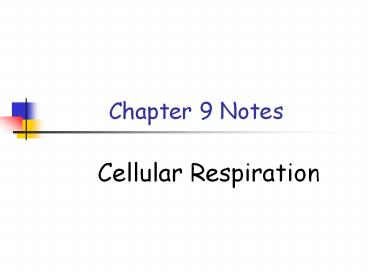Chapter 9 Notes - PowerPoint PPT Presentation
Title:
Chapter 9 Notes
Description:
Chapter 9 Notes Cellular Respiration 9-1 Chemical Pathways All living organisms need food to survive. Food provides living things with the chemical building blocks ... – PowerPoint PPT presentation
Number of Views:109
Avg rating:3.0/5.0
Title: Chapter 9 Notes
1
Chapter 9 Notes
- Cellular Respiration
2
9-1 Chemical Pathways
- All living organisms need food to survive.
- Food provides living things with the chemical
building blocks they need to grow and reproduce.
3
9-1 Chemical Pathways
- 1 gram of glucose releases 3811 calories of heat
energy - Calorie (c) the amount of energy needed to raise
the temperature of 1 gram of water 1 Celsius
degree - The calories on food labels (C) are kilocalories
or 1000 calories
4
9-1 Chemical Pathways
- Cells gradually release energy from glucose and
other food compounds. - Cellular respiration is the process that releases
energy by breaking down food molecules in the
presence of oxygen. - - 3 parts glycolysis, the Krebs cycle, and the
electron transport chain
5
Electrons carried in NADH
Pyruvic acid
Electrons carried in NADH and FADH2
Glucose
Glycolysis
Krebs Cycle
Electron Transport Chain
Cytoplasm
Mitochondrion
6
9-1 Chemical Pathways
- Equation for Cellular Respiration
- 6O2 C6H12O6 ? 6CO2 6 H2O Energy
- oxygenglucose ?carbonwaterenergy
- dioxide
7
9-1 Chemical Pathways
Glucose
Krebs cycle
Electrontransport
Glycolysis
Alcohol or lactic acid
Fermentation (without oxygen)
8
9-1 Chemical Pathways
- The first set of chemical reactions in cellular
respiration is glycolysis. - Glycolysis is the process in which one molecule
of glucose is broken in half, producing two
molecules of pyruvic acid, a 3-carbon compound
9
9-1 Chemical Pathways
- Net results of glycolysis
- - 2 molecules of ATP are gained
- - 2 molecules of NADH are gained
- - 2 molecules of pyruvic acid (3C) are formed
from 1 glucose molecule
10
9-1 Chemical Pathways
4 ADP
2 ATP
2 ADP
4 ATP
Glucose
2 Pyruvic acid
11
9-1 Chemical Pathways
- When oxygen is present in the cell, glycolysis is
followed by the Krebs cycle. - If there is no oxygen present, glycolysis is
followed by fermentation. - Fermentation releases energy from food molecules
in the absence of oxygen
12
9-1 Chemical Pathways
- Because fermentation does not require oxygen it
is said to be anaerobic. - The two main types of fermentation are alcoholic
fermentation and lactic acid fermentation
13
9-1 Chemical Pathways
14
9-1 Chemical Pathways
15
9-1 Chemical Pathways
- Alcoholic fermentation is used mainly by plants
and yeasts - - alcohol is the product
- Lactic acid fermentation occurs in muscle cells
when the body cannot supply enough oxygen to the
tissues - - lactic acid is the product
16
Section Quiz
- The raw materials required for cellular
respiration are - carbon dioxide and oxygen.
- glucose and water.
- glucose and oxygen.
- carbon dioxide and water.
17
Section Quiz
- Glycolysis occurs in the
- mitochondria.
- cytoplasm.
- nucleus.
- chloroplasts.
18
Section Quiz
- The net gain of ATP molecules after glycolysis is
- 3 ATP molecules.
- 2 ATP molecules.
- 3 pyruvic acid molecules.
- 4 pyruvic acid molecules
19
Section Quiz
- Fermentation releases energy from food molecules
in the absence of - oxygen.
- glucose.
- NADH.
- alcohol.
20
Section Quiz
- The first step in fermentation is always
- lactic acid production.
- the Krebs cycle.
- glycolysis.
- alcohol production.
21
9-2 The Krebs Cycle and Electron Transport
- Oxygen is used for the final steps of cellular
respiration. Because the pathway requires
oxygen, it is said to be aerobic. - In the presence of O2, pyruvic acid passes on to
the second stage of cellular respiration, the
Krebs cycle
22
9-2 The Krebs Cycle and Electron Transport
- During the Krebs cycle, pyruvic acid is broken
down into carbon dioxide in a series of
energy-extracting reactions - Net result of the Krebs cycle
- - 2 molecules of pyruvic acid enter
- - 8 molecules of NADH are gained
- - 2 molecules of FADH2 are gained
- - 2 molecules of ATP are gained
23
Mitochondrion
Citric Acid Production
24
9-2 The Krebs Cycle and Electron Transport
- From glycolysis and the Krebs cycle high energy
electron carriers, NADH and FADH2, are produced.
The electrons are then passed to the electron
transport chain. - The electron transport chain uses high energy
electrons to convert ADP to ATP. - ETC Movie pt 1
- ETC Movie pt 2
25
9-2 The Krebs Cycle and Electron Transport
26
9-2 The Krebs Cycle and Electron Transport
27
9-2 The Krebs Cycle and Electron Transport
28
9-2 The Krebs Cycle and Electron Transport
ATP synthase
29
9-2 The Krebs Cycle and Electron Transport
Channel
ATP synthase
ATP
30
9-2 The Krebs Cycle and Electron Transport
- Each NADH make 3 ATP while each FADH2 makes 2 ATP
- 1 glucose molecule can then make 38 total ATP ( 4
ATP, 10 NADH ? 30 ATP, 2 FADH2 ? 4 ATP) - Cellular Respiration Animation
31
Section Quiz
- The Krebs cycle breaks pyruvic acid down into
- oxygen.
- NADH.
- carbon dioxide.
- alcohol.
32
Section Quiz
- In eukaryotes, the electron transport chain is
located in the - cell membrane.
- inner mitochondrial membrane.
- cytoplasm.
- outer mitochondrial membrane.
33
Section Quiz
- To generate energy over long periods, the body
must use - stored ATP.
- lactic acid fermentation.
- cellular respiration.
- glycolysis.
34
Section Quiz
- Which statement correctly describes
photosynthesis and cellular respiration? - Photosynthesis releases energy, while cellular
respiration stores energy. - Photosynthesis and cellular respiration use the
same raw materials. - Cellular respiration releases energy, while
photosynthesis stores energy. - Cellular respiration and photosynthesis produce
the same products.































